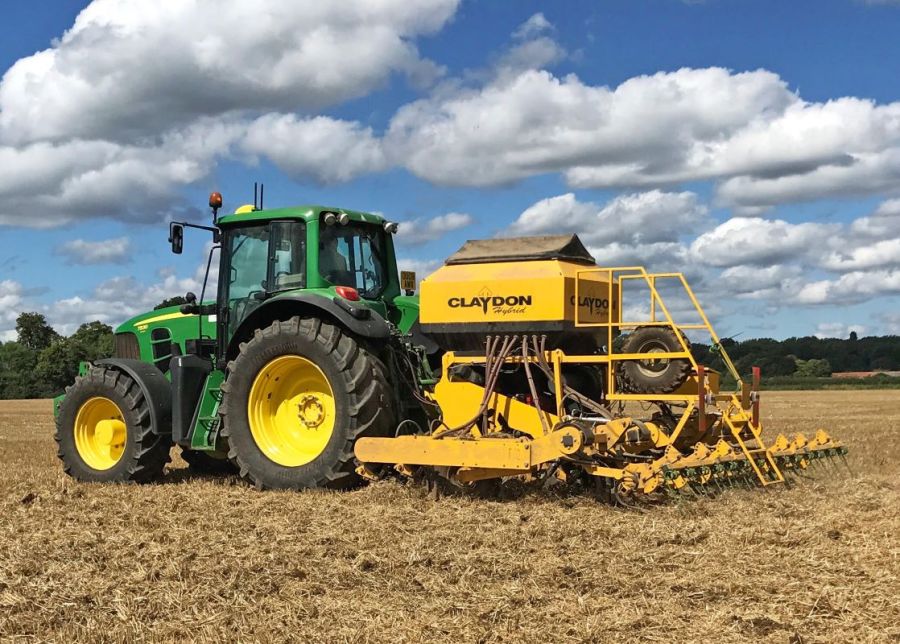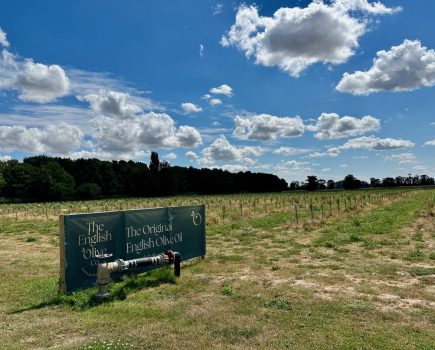Ensuring long-term sustainability has become a core focus for many growers during recent years. CPM speaks to one Berkshire farmer about the practical lessons of regenerative agriculture and how cover crops are reshaping farm resilience and profitability.
“We’re not abandoning commercial farming – we’re making it fit for the future.” ANDREW RANDALL
By Charlotte Cunningham
On the light soils of the Berkshire-Buckinghamshire border, Randall Farms is quietly reworking its business to ensure long-term sustainability. Beneath the rolling chalk and gravel terrain lies a story of soil-first agronomy, where regenerative practices – particularly the integration of cover crops – are paying tangible dividends.
Farming 350ha of owned and rented land spanning across two sites, Andrew Randall has turned the business from a conventional arable setup into a diverse rural enterprise where cover crops underpin both productivity and profitability. “If we’re going to grow them, we must do it properly,” he says, reflecting on the farm’s mission statement of optimising the land while enhancing its amenity.
Arguably ahead of the curve, the transition to a more regenerative system began in 2011 when Andrew took the first steps away from a high-input, high-disturbance system. He says this was driven not by fashion, but necessity: improving soil structure, managing erratic rainfall, and maintaining profitability on predominantly sandy clay loam soils. “Our ‘max-till’ approach – plough, power harrow, drill – was complete overkill on this land. We were burning diesel, wearing metal, overworking soils, and creating compaction that made us vulnerable to drought.”
This was only exacerbated by the desire to preserve soil structure and make better use of residual fertility – something which had been in limited supply since the dispersal of the dairy herd which once grazed the fields. “We’d lost the herd by 2002 due to unreliable forage production and with that went the regular manure inputs which were so important for boosting soil organic matter,” explains Andrew, “So, the focus turned to using biology – worms, roots, residues – to do the heavy lifting.”
As part of this, Andrew made the decision to incorporate cover cropping into the rotation, well before support payments made growing them fashionable. “We began sowing them to improve soil function, water retention, and nutrient cycling. There was no financial support under what was then the Countryside Stewardship Scheme, but we were seeing physical differences.
“There was a lot of worm activity in the main areas of our fields so I wanted to capitalise on that by maintaining the channels they make through the soil and retaining existing root structures from previous crops.
“We also worked closely with South East Water who were keen to encourage farm management techniques which help to minimise run-off, prevent soil getting into water courses such as the River Thames, and store rainwater in the soil, but essentially we were doing it off our own back, at our own expense.”
The primary goal of cover crops was to homogenise the upper soil layers and make them easier to manage, which ultimately led to direct drilling and a rethink of what was in the drill shed, notes Andrew.
“We experimented with the technique on a small scale for a couple of years by hiring an old Claydon SR (Stone Release) drill to establish trial areas. During that time, we also visited prominent farmers who were direct drilling, including James Dockery in Hampshire who operated tine and disc-type direct drills over several thousand acres, and Tony Reynolds in Lincolnshire, who both generously shared their wisdom.”
With a wide range of soil types, Andrew felt two drills would be the best option and so a 3m Claydon Hybrid and a second-hand John Deere 750A arrived in 2011. “With such a range of soil types we wanted flexibility. The tine-based Claydon gave us the clearance and strength for heavy trash, while the disc drill was better on clean stubbles.”
Three years later Andrew progressed to a 4m mounted Claydon Hybrid and upgraded his 3m disc drill to a newer 4m model. Then in 2023, he took advantage of the Rural Payment Agency’s Farming Equipment and Technology (FETF) grants to step up to a new 4m Claydon Evolution direct drill fitted with front discs and a liquid applicator which delivers fertiliser to the front tines.
Today, cover crops are sown on two out of every eight cropping slots – before spring oats and spring beans. “The goal is to keep a living root in the soil for as long as possible; we don’t want bare land baking from July to October. Cover crops capture sunlight, build organic matter, and feed soil biology.”
ADAPTABILITY
Mixtures vary by crop and field objective. Ahead of spring beans, a 50kg/ha mix of 86% oats, 10% vetch, and 4% phacelia costs around £24/ha. Before spring oats, a more diverse 30kg/ha mix of vetch, peas, linseed, buckwheat and sunflower costs around £32/ha. “It’s not the cheapest option,” admits Andrew, “But the biomass production and soil activity make it worthwhile; we’ve trialled enough to know that the value is in doing it properly, not cutting corners.”
For seed advice, Andrew works closely with Cotswold Seeds. Director Paul Totterdell says the key to successful cover cropping lies in clarity of objective and appropriate species selection.
“Cheap mixes often rely on brassica species – they’re fast-growing but don’t support mycorrhizae. A well-constructed mix requires deep-rooting plants, legumes for nitrogen, and diverse root architectures for soil the best soil improvement.”
Paul also warns about sowing depth and calibration. “Small seeds like clover and phacelia mustn’t go deeper than 10mm which means drills must be capable of accurate metering and shallow placement.”
To improve accuracy, some customers now request mixes supplied in species-specific components to be sown from separate hoppers. “It’s more work but it reflects the increased sophistication of farmers like Andrew,” he believes.
When it comes to getting cover crops right, if there’s one rule Andrew swears by, it’s timing. “Every day of August growth is worth two in September. That’s why the cover crop drill is always hooked up and ready. As soon as the combine stops, we go.”
This knowledge has come via many different trials carried out on the farm during the years to really dig into exactly what works for them, adds Andrew.
A key learning has been that poor establishment carries a cost, proven in a trial which compared a well-established cover crop with a delayed one in the same field. The early-sown crop contained 201kgN/ha of total nitrogen, half of which was available to the following crop. The delayed section contained just 33kgN/ha. Potassium levels showed similar trends.
“That’s your margin right there,” states Andrew. “Delaying drilling by a week or not having the drill ready can mean losing more than 100kg/ha of available nutrients. When the cost of doing it right is £130/ha, you can’t afford to do it badly.”
The Claydon’s leading tine coulters help maximise that early establishment too, he adds. “They clear trash, lift moisture, and avoid ‘hairpinning’. In dry conditions, they outperform the disc drill hands down.
“Sometimes where we’ve used a disc drill, the cover crops take longer to get going, and in hard, dry conditions the cost of wearing metal is higher. The Claydon’s leading tines sweep through the trash and bring moisture into the seeding zone which promotes rapid establishment.”
While cover crops have proved a success for Andrew, they do come with their challenges – namely slug pressure, particularly in brassica-heavy mixes. “Mustard attracts slugs, so we were losing crops despite pellets,” recalls Andrew. “As a result, mustard has been dropped from the seed mixes.”
The farm is also participating in BOFIN’s SLIMERS project, looking at the spatial dynamics of slugs and resistance strategies. “Early results suggest slugs are more localised than we think; we may not have to blanket apply pellets. It’s a case of using data to inform practice.”
ECONOMIC VIABILITY
Reflecting on the progress so far and considering what lies ahead, Andrew says Randall Farms’ regenerative journey isn’t about ideology. Rather it’s about building a system that works – economically, biologically, and practically. “We’re still producing high-spec grain for end users within 50 miles. We’re not abandoning commercial farming – we’re making it fit for the future.”
And the results are clear in the field: improved water infiltration, reduced fuel use, stronger crop rooting, and a growing sense of biological balance. Andrew concludes: “Regenerative agriculture isn’t a shortcut, it’s a long-term strategy that demands investment and attention to detail. But it’s a route to profitability that doesn’t depend on inputs we no longer trust or can afford.”
This article was taken from the latest issue of CPM. Read the article in full here.
For more articles like this, subscribe here.
Sign up for Crop Production Magazine’s FREE e-newsletter here.




